 Is identi.ca the savior of microblogging? Or is it simply Yet Another Twitter Clone destined for doom?
Is identi.ca the savior of microblogging? Or is it simply Yet Another Twitter Clone destined for doom?
THE GREAT HOPE
As those of us of the Twitterati watched the FailWhale appear multiple times today and wrote posts like mine wondering if we should just give up on Twitter, there was this afternoon a moment when the clouds parted, the trumpets sounded and a bright beacon of hope appeared before us all… here came the launch of identi.ca, an… (gasp)… open source version of Twitter!
Dave Winer declared “Oh happy day!?” and Marshall Kirkpatrick was out with the first longer writeup: “Identi.ca: May A Million Twitters Bloom” (which is definitely worth a read). Those links were twittered and re-twittered…
What happened next was of course entirely predictable… about 1,000 people jumped over to identi.ca to set up accounts (myself included, I’m identi.ca/danyork)… and swamped the server. There was no way that any brand-new service could measure up to the repressed frustration of the Twitterati, and so there was the inevitable backlash…
…the user interface sucks… this doesn’t look like a Twitter-killer… I’m not getting all the updates… the Jabber integration doesn’t work for me… ugh, this isn’t good!… where’s the API?… what do you mean there’s no SMS interface?… why are the RSS feeds broken?… how can I see replies?… do I REALLY need yet another <expletive> service?
Beyond showing that people need to chill out a bit and give a new service time to develop, the comments somewhat miss the point:
The success or failure of the site, identi.ca, really doesn’t matter.
What matters most was very nicely summarized in a post (what do we call them? they aren’t “tweets”!) by Edd Dunbill:
THE REAL POWER
The real power resides in the actual software being used, called Laconica, that is used by identi.ca. It is open source/free software and licensed under the GNU Affero General Public License. As stated in the FAQ:
How is Identi.ca different from Twitter, Jaiku, Pownce, Plurk, others?
Identi.ca is an Open Network Service. Our main
goal is to provide a fair and transparent service that preserves users’ autonomy. In
particular, all the software used for Identi.ca is Free Software, and all the data is available
under the Creative Commons Attribution 3.0 license, making it Open Data.
The software also implements the OpenMicroBlogging protocol, meaning that you can have friends on other microblogging services
that can receive your notices.
The goal here is autonomy — you deserve the right to manage your own on-line
presence. If you don’t like how Identi.ca works, you can take your data and the source code and set up your own server (or move your account to another one).
That last line is key… “If you don’t like how Identi.ca works, you can take your data and the source code and set up your own server (or move your account to another one).” As Aswath said:
THE PROVERBIAL GENIE IS OUT OF THE BOTTLE
Anyone can now start up their own Twitter-equivalent. In fact, Russ Beattie already has… http://foozik.com/ is up and running with the Laconica code.
More will follow. Someone will throw it up on Amazon’s EC2 and put a cloud computing infrastructure behind it. Once Google’s AppEngine supports PHP (which the Laconica code uses), someone will throw it up there. Someone will make it work on the evolving P2P network clouds. Someone will add code for an SMS gateway… someone will add a solid API. Someone will add the Replies tab and improve the UI.
Many implementations will suck. Some will suck badly. But others will excel… and somewhere in all of that something resembling the next Apache or WordPress may emerge. Will it be Laconica? Maybe… or maybe some fork or derivative work. Or maybe some other version written in another language but inspired by the Laconica work.
Of course, just because anyone can “run their own Twitter” doesn’t mean they will. Most folks won’t. But some will. Other users will join those services. Maybe the identi.ca site will lead the pack… maybe some other implementation will eclipse its lead. The individual sites don’t really matter as much as the software that powers them.
WEAVING THE TAPESTRY
Of course, to make such a distributed / decentralized system work, the individual servers need to understand how to connect to other users. As Marshall writes:
Ultimately, this means federation. I put a customized version of the foundation software (called Laconi.ca) on my server, you put one to your liking on yours, we both get friends on our local copy and any other versions around the web – and everyone can communicate with each other just like we were using the same service from the same provider. Whoever comes up with the best alternative to the garbled name Identi.ca wins!
That’s the hard part. Coming up with a way to easily and securely pass information between the servers… and to uniquely identify users running on the different servers. The good news is that there are some folks already looking at this through the OpenMicroBlogging initiative (that, like Marshall, I had not heard of before today).
The other good news is that we have multiple precedents for doing this before. Think of Jabber and XMPP. I have a Jabber ID (JID) of “dyork@jabber.org” (or “danyorklpg@gmail.com”). I can do XMPP-based IM with anyone else who has a JID. Our servers can resolve the JIDs and communicate with the servers. Each of us can be running our own Jabber server – yet we can all find and communicate with each other.
Or think of email. Each of us has the option of running many different kinds of email servers. Yet we can all communicate through an open standard, SMTP, and we can be uniquely identified with our address.
BUT WILL IT KILL TWITTER?
Probably not. Let’s be real… Twitter has hundreds of thousands of active users these days (maybe more?). At some point, they’ll fix their stability problems. People will stay there because their “community” is there. Let’s face it, simply the existence of an open source IM solution (Jabber/XMPP) hasn’t killed off the walled gardens of AIM, MSN/WLM and Yahoo!Messenger.
But Laconica and it’s impending derivatives gives us all a “Plan B”… it gives us choice and “control”… when we finally hit that pain threshold and decide to move on… there’s another choice out there.
More than that, the release of Laconica unleashes the “power of play”… developers can now tinker with the code… change it… improve it… do wacky things with it that Evan at identi.ca had never even remotely dreamed of. Every developer who gets pissed off at yet more Twitter downtime now has a building block to launch off in pursuit of “building a better Twitter”.
Sure, the code needs work… maybe lots of work… that’s okay. It’s a building block.
At the very least there is the potential of competition for Twitter… competition is good. It keeps the leaders on their toes… and fosters innovation.
THE MISSING MEDIUM
The phenomenal success of Twitter has shown us that we were missing a communication medium.
Somewhere in the midst of email, IM, web sites, blog sites, IRC, video, RSS feeds, Facebook, MySpace, VoIP, cell phones, snail mail and everything else… we wanted yet another way to communicate. The one-to-many mode of Twitter… mixed in with a one-to-one mode… and accessible through a wide range of devices and a simple API.
Twitter’s very simple question of “What are you doing?” showed that there was desire out there to provide “status updates”… which evolved into everything else we do now with Twitter. And now pretty much every “social networking” site out there along with IM services and many other apps have added “status updates”.
IT’S ALL ABOUT CONTROL
As early adopters and users, our frustration, though, has been that the services allowing us to publish those updates have been out of our control. Whether it’s been Twitter, Jaiku, Pownce, Facebook, MySpace, LinkedIn, Plaxo Pulse, Skype… or… pick your service… we are locked into their infrastructure. We can’t experiment with it. We can’t tinker with it. We can’t hack on it. We can’t fix it. All we can do is pound our head against walls…
With identi.ca and Laconica, we see the hope to regain that control. Some of us want that, while others admittedly don’t care – they just want a service that works. There are many barriers to such a service reaching the level of usability that we probably want. It may never get there. Twitter may mystically fix all its issues and we’ll just stay over there and this whole thing will fade into the background of other available-but-not-widely-used open source and free software.
We’ll see.
Meanwhile, the code is out there for those who want to play with it. As Marshall said “May A Million Twitters Bloom”… let the hacking away on the code begin… it will be fun to see what evolves…
P.S. You can find me at identi.ca/danyork as well as twitter.com/danyork
Technorati Tags:
twitter, identi.ca, laconica, microblogging, opensource, freesoftware, status
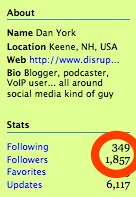 With Twitter, or for that matter any other microblogging platform, do you follow everyone who follows you?
With Twitter, or for that matter any other microblogging platform, do you follow everyone who follows you?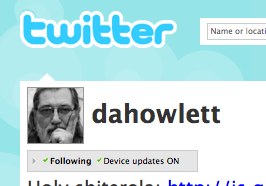
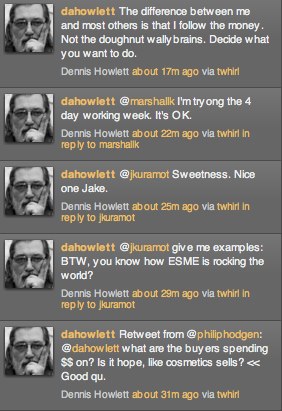
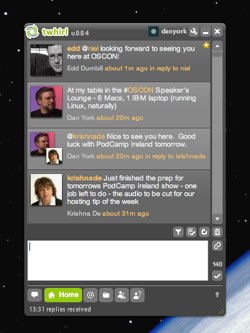 Yesterday, the big news in the microblogging world was
Yesterday, the big news in the microblogging world was
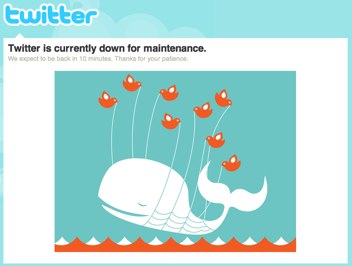
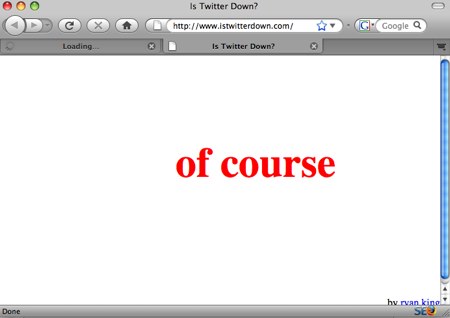
 I was amused to see in my Twitter stream a tweet from local (Burlington, VT) TV station
I was amused to see in my Twitter stream a tweet from local (Burlington, VT) TV station  I have to admit that I don’t quite get
I have to admit that I don’t quite get